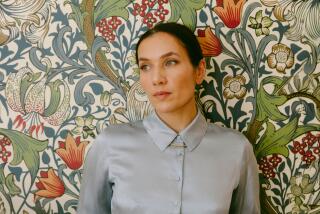PRETTY APPEALING : Softer, Fitted and Feminine, Spring Wear Makes a Comely Comeback
- Share via
At a recent showing of Nolan Miller’s spring/summer couture collection in Irvine, a woman who had viewed the parade of floaty chiffon dresses and elegant gowns remarked:
“It’s so nice to see pretty clothes--for a change.”
Women’s complaints that designers aren’t creating enough pretty clothes, and that stores aren’t carrying them, have been getting louder in recent years.
On the runways and in fashion magazines, outrageous styles such as plastic miniskirts and see-through blouses have alienated those who simply want an attractive suit for work or a classic dress for lunch.
“A lot of designers are there to shock everyone. The clothes are so ridiculous. It looks like the circus has come to town,” Miller says. “It’s difficult to look at the fashion magazines from Milan and see that they’ve made women look like freaks.”
The L.A.-based fashion designer, who created the glamorous styles for “Dynasty,” says he just wants women to look feminine. Not all designers share his philosophy. Some are more concerned with attracting attention than making women look attractive.
The fashions that come down the runways aren’t meant to be worn; they’re created just for publicity, says Doris Fuqua, coordinator of the fashion department at Fullerton College.
“Many of my students ask, ‘Who would wear that?’ The answer is ‘nobody,’ ” Fuqua says. “They’re to sell the name of the designer, not the clothes. Most of them are never produced. It’s up to manufacturers to make them marketable.”
Trends such as the lingerie look, which started with models walking down runways in corsets and bustiers, get watered down to be more palatable to the public. Unfortunately, many manufacturers and retailers are so busy trying to appeal to the greatest number of customers that they end up offering bland clothing.
“There are a lot of generic clothes out there. A lot of women buy them thinking they’re investment pieces. They’re not. They’re blah pieces,” says Sandra Graham, spokeswoman for Escada Inc. in New York City.
“Manufacturers, in their effort to appeal to everyone, are appealing to no one. I don’t want the same suit that my daughter, my mother and my grandmother can wear. It’s not individual enough.”
The grunge movement, with its shapeless dresses and baggy plaid shirts, has left many fuming about ugly clothes.
“The fashion industry cut its own throat with the grunge movement,” Miller says. “Older women don’t want to wear combat boots.”
Yet the demise of pretty clothes began many years before grunge. Some fashion experts say women’s clothing has been on the decline for decades.
“We got so anti-Establishment in the ‘60s--that’s when blue jeans came into their own,” says Kitty Leslie, a Newport Beach fashion consultant.
That’s also when women stopped wearing hats and gloves. There was less emphasis on cultivating a tailored, put-together look a la Jackie Kennedy.
Economics is responsible for many of the plain clothes on the market today.
Beautiful fabrics such as fine silk chiffons are expensive, so manufacturers cut corners by making garments out of less costly material.
“You can’t make a good-looking dress out of a bad fabric,” Fuqua says.
Pretty details such as scalloped collars, jeweled buttons and hand-rolled piping also make the garment more costly to produce and reduce the number of customers who will want to buy it.
“If you add on ruffles and frills, you narrow the potential customers to those who like ruffles,” Fuqua says. “It’s what the market will bear.”
Many of the shapeless styles on the racks today can be traced to higher labor costs.
“When you get more feminine, you get more fit. Then you have to do more specific sizing, and that’s more expensive,” Fuqua says. “Every time you sew a seam, it costs money. And a straight seam costs less than a curved one.”
In addition, fewer customers can wear fitted garments, because they don’t conform to standard sizes.
“A customer’s bulge must be in the same place as the bulge in the seam, or she won’t buy it,” Fuqua says.
For their economic survival, manufacturers churn out slip dresses, loose-fitting tunics and other one-size-fits-all styles.
“There’s so much competition for the consumer dollar that stores are not willing to invest in something unless they’re sure it’s going to sell,” Fuqua says. “They tend to buy safe. But people who like unique things won’t buy it.”
Amid the grumbling about women’s clothes, there are signs that pretty is making a comeback. This spring women’s fashions have seen a return of color--pastels and brights--as well as soft floral prints in form-fitting, feminine shapes.
“Clothes are getting prettier,” Leslie says. “It’s nothing overwhelming, but there’s a great deal of emphasis on florals--and they’re pretty florals, too, not the garish ones we had in the past.”
The grunge look is fading fast, she says, and so is “that awful hard bra, underwear look made popular by Madonna.”
Holly Sharp, a Newport Beach-based fashion designer who has long favored feminine looks, says women have been more interested in looking powerful than pretty, but that’s changing.
“Before they didn’t want sweet and pretty,” she says. “Women are softening up a lot. It comes with a level of confidence.”
More women are unafraid to flaunt their femininity, she says. One sign of change is the success of Sharp’s simple, caramel-colored sheath with the silk organza bow around the waist, which she offered this spring.
“Last year, I wouldn’t have had the nerve to put on that bow,” Sharp says. This year, the bow is a hit, along with other pretty details and trim. Her pastel suits and short cocktail dresses are doing well too.
“It’s really my time,” Sharp says.






